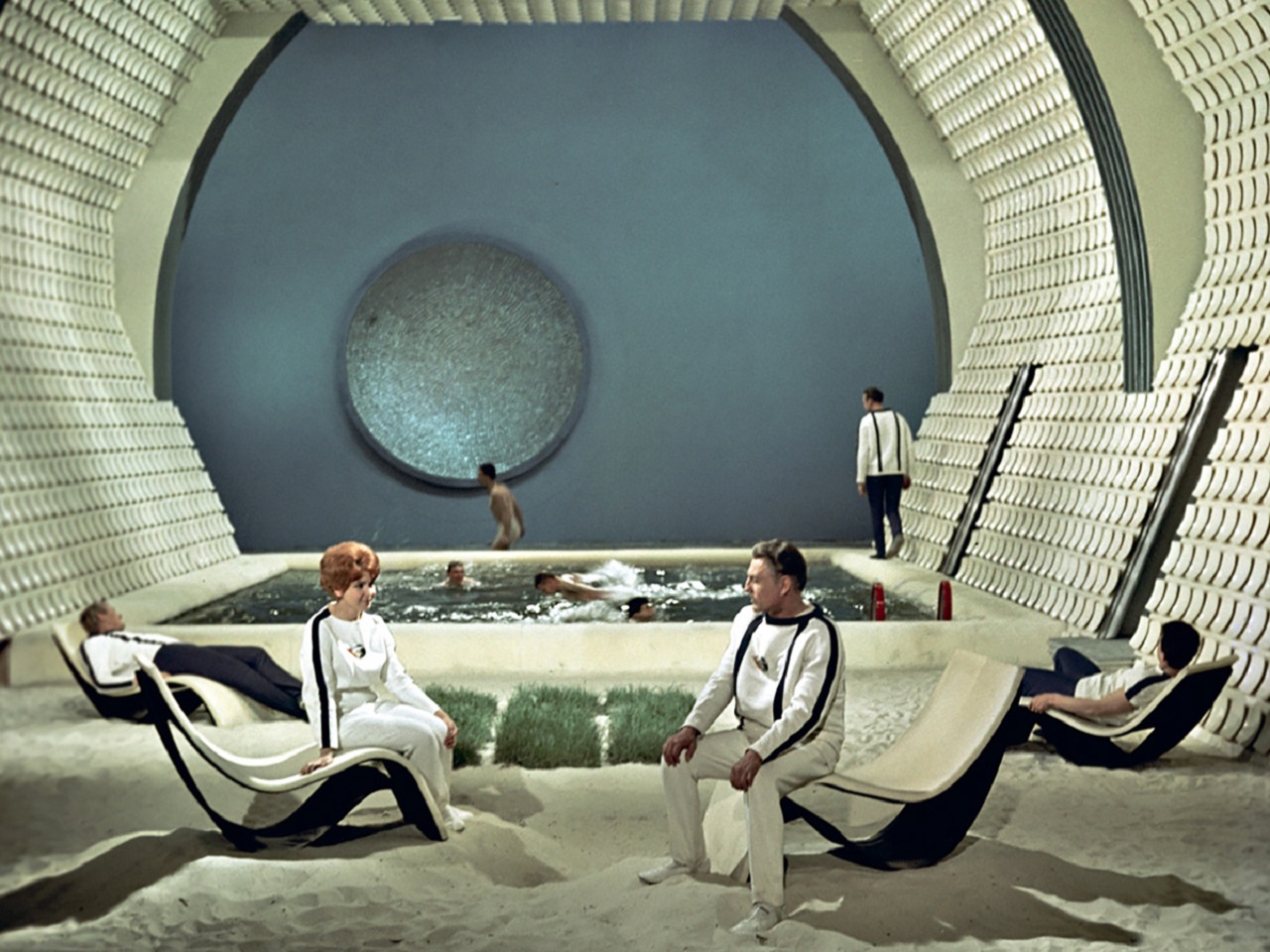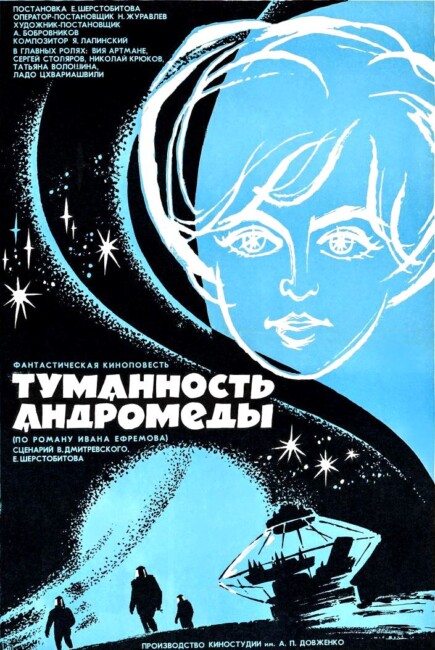(Tumannost Andromedy)
USSR. 1967.
Crew
Director – Yevgeny Sherstobitov, Screenplay – B. Dmitriyevskiy & Yevgeny Sherstobitov, Based on the Novel by Ivan Yefremov, Photography – Nikolai Zhuravlyov, Music – Yakov Lapinsky, Production Design – Aleksey Bobrivnikov. Production Company – Dovshenko Film Studios.
Cast
Nikolai Kryukov (Erg Noor), Sergei Stolyarov (Dar Veter), Tatyana Voloshina (Niza Krit), Vija Artmane (Veda Kong), Lado Tskhvariashvili (Mven Mars)
Plot
Spaceships are sent out from Earth to explore the Great Ring in search of intelligent life. One such expedition, commanded by Erg Noor, is drawn into the powerful gravitational pull of an iron star. Erg makes the decision to land on one of the two orbiting planets. They put down near the site of a crashed ship but in doing so use up the last of the anameson fuel they need to lift off again. They explore the other ship but also encounter alien creatures living in the mists. Erg must also deal with the affections of crewmate Niza Krit who loves him and wants to be near him at all times.
The era of the Space Race gave birth to a great boom in science-fiction films in The West. Although they never received much attention in the West, there was a parallel boom in the Eastern Bloc countries. In very similar ways, the Soviets created a body of science-fiction films about reaching for the stars. These included the likes of The Heavens Call (1959), Storm Planet (1962), Solaris (1972), Moscow-Cassiopeia (1973), Per Aspera Ad Astra (1981) and Moon Rainbow (1983), among others, as well as other efforts from Eastern Bloc countries such as First Spaceship on Venus (1959) and Voyage to the End of the Universe (1963). (See Soviet Cinema).
Unlike the Western equivalents, the Soviet films are not rent through with fear and anxiety about alien invaders coming to wipe out or infiltrate the American way of life, or of atomic monsters on the rampage. Under strict state censorship, the Soviet SF films were made to portray messages that upheld the Communist society. Andromeda Nebula is based on a 1957 novel by Ivan Yefremov, a popular work that largely defined science-fiction as a genre for the Soviets, and was widely read in the USSR for its promotion of a vision of an intergalactic society based on social equality.
Andromeda Nebula comes with the typical idealistic boldness of the other Soviet films of the era. It, for instance, opens on some type of Olympic ceremony with young athletes up against a giant-sized representation of a hand holding a burning flame pledging their labour (presumably to the state). It also has the problems of almost every one of the above-listed Soviet science-fiction films – that is to say they were frequently talky and dull, featured stolid characters, and never seemed to find any of the drama that the US-made equivalents did.

The film at least tries to make the characters on board the spaceship interesting by adding scenes where one of the crewwomen (Tatyana Voloshina) develops a crush on captain Nikolai Kryukov – something that seems a little pathologically stalkerish today – but this is dully directed. The drama on the surface of the alien planet is constantly interspersed with cuts to a romantic triangle back at homebase, although you never figure out what this is all about.
Part of the problem is that Andromeda Nebula was apparently intended as a two-part film but the second part was never made – the IMDB claims that this was due to Ivan Yefremov falling out of favour with the Soviet authorities but I am unable to find anything in Yefremov’s biography that corroborates this. Wikipedia meanwhile makes the far more credible claim that the second part was never made due to the death of actor Sergei Stolyarov in 1969.
One of the pluses of the Soviet science-fiction films is that they always had far better budgets available to them than their American counterparts – all due to their being produced by state-funded studios rather than independent B-budget studios intended principally for drive-in audiences. There are some fabulous sets – a magnificent control room of the spaceship with a giant port window designed like a target; indoor swimming pools aboard the spaceship; Dar Veter’s office built with one wall as a giant glass window that looks out over a cliffside stretching beyond it.
Once the expedition lands, the budget gives impressive size to the spaceship, planetary surface and exploration vehicle. It is during these scenes that the dull shipboard and planetside drama back home starts to perk up and become interesting. Even so, director Yevgeny Sherstobitov never manages to build the exploration of the planet to anything interesting. Compare Andromeda Nebula to other films exploring alien ships such as Planet of the Vampires (1965) and especially Alien (1979) and see how underdeveloped these scenes are.
Full film available here (no subs)


